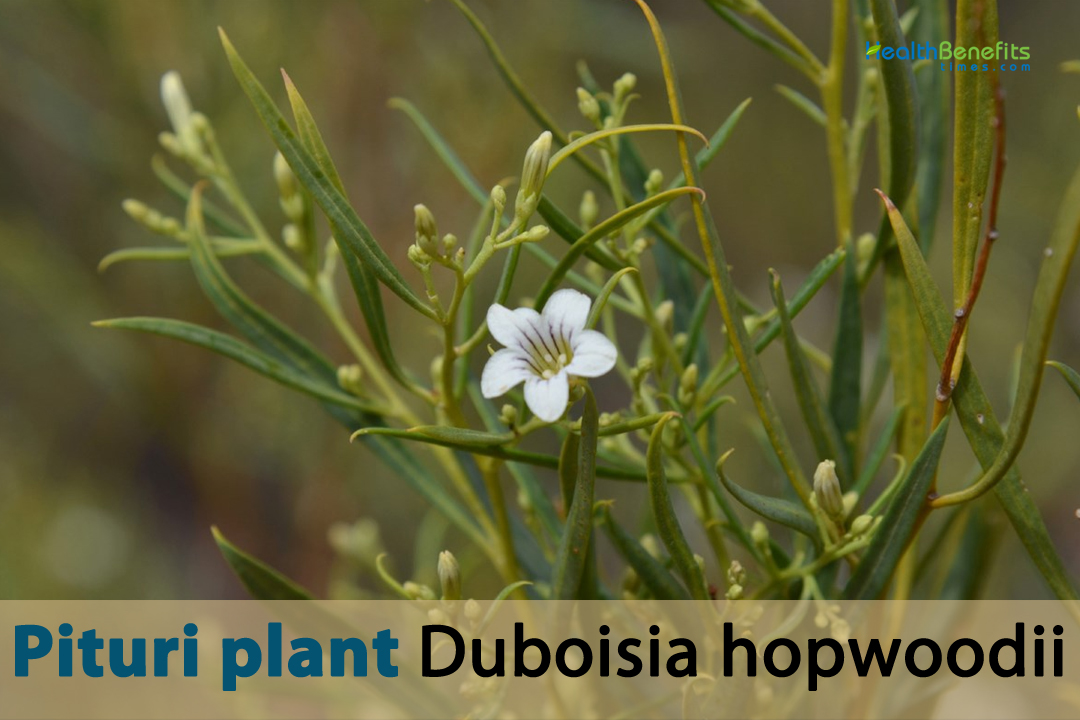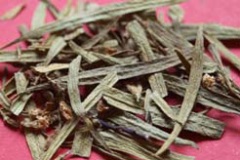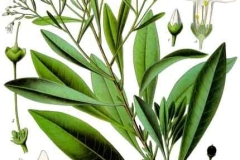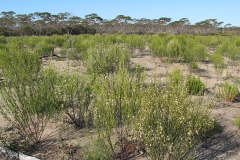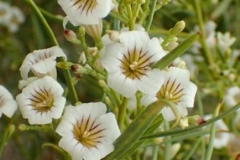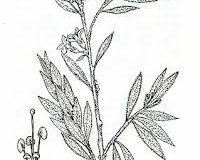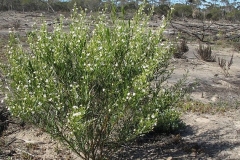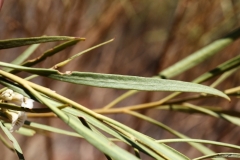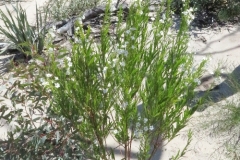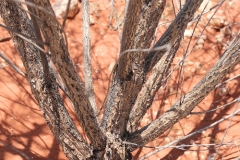The name “Duboisia” comes from the last name of Charles-Francois Dubois, a French scientist. His work on putting plants into groups was well-known. The name “Duboisia” is an honor to what he did for the science of plants. The name “hopwoodii” is a nod to Richard Hopwood, an English botanist and plant collector who helped study and collect plants, especially in Australia. Using a special epithet like “hopwoodii” is a way to honor and recognize people who have made important contributions to the field of botany. Indigenous groups chewed Pituri for ceremonies, social events, and to bring people together. It was often shared at gatherings, ceremonies, and cultural events, which helped people, get to know each other and build bonds.
Pituri Plant Facts
| Pituri plant Quick Facts | |
|---|---|
| Name: | Pituri plant |
| Scientific Name: | Duboisia hopwoodii |
| Origin | Australia, including areas in New South Wales, Northern Territory, Queensland, South Australia, Western Australia |
| Colors | Purple-black |
| Shapes | Small, long, and spherical capsules |
| Taste | Mix of bitterness, earthiness, and a mild sweetness |
| Major nutrients | • Nitrogen • Phosphorus • Potassium • Calcium • Magnesium • Sulfur • Iron • Manganese • Zinc • Copper • Boron • Molybdenum |
| Health benefits | Suppress Appetite, Respiratory Conditions, Cognitive Enhancement, Mild Pain Relief, Energetic Boost, Mood Enhancement, Digestive Aid, Social and Cultural Benefits |
| Name | Pituri plant |
|---|---|
| Scientific Name | Duboisia hopwoodii |
| Native | Arid and semi-arid regions of Australia, including areas in New South Wales, Northern Territory, Queensland, South Australia, Western Australia |
| Common Names | Pituri, pitchuri thornapple or pitcher, Duboisia, Piturie bush, Pituri tree, Pitcheri, Pituri plant, Corkwood, Pitchuri, Pittory, Pituris, Pitourie, Pitory, Pitoura, Black-pituri, Piturika, Pitury, Berrima, Poison bush, Piturri, Pituri shrub, Piturya, Piturin, Pitari |
| Name in Other Languages | Afrikaans: Pituri-plant Amharic: Abāy frāfere (አባይ ፍራፍሬ) Arabic: Nabat al-Biturī (نبات البيتوري), Nabat el-Bētūrī (نبات البيتوري) Armenian: Pituri buis (Պիտուրի բույս) Azerbaijani: Pituri bitkisi Basque: Pituri Landare Belarusian: Raslina Pituri (Расліна Пітурі) Bengali: Piṭuri gācha (পিটুরি গাছ) Burmese: Pituri apang (ပီတူရီအပင်) Catalan: Planta de Pituri Chamorro: Langet Pituri Cherokee: Pituri Chinese: Pí tú lǐ zhí wù (皮图里植物) Choctaw: Pituri Pokoli Chuukese: Sap Pituri Cree: Pituri, Usirvapamaawin (ᐅᓯᕐᕙᐹᒫᐏᐣ) Czech: Pituri rostlina Danish: Pituri plante Dutch: Pituri-plant English: Pituri, Pitchuri thornapple Estonian: Pituri Taim Fijian: Veitarogi ni Pituri Filipino: Halaman ng Pituri Finnish: Pituri-kasvi, Tupakkapituri French: Plante de Pituri Galician: Planta de Pituri Georgian: Mtsenare Pituri (მცენარე პიტური) German: Pituri-Pflanze Greek: Fytó tou Pitourí (Φυτό του Πιτούρι) Greenlandic: Pituri Illuat Gujarati: Pituri Vriksh (પિટુરી વૃક્ષ), Pituri No Vanaspati (પિટુરીનો વનસ્પતિ) Hausa: Cikin Ganye na Pituri Hawaiian: Lāʻau Pituri Hawaiian Pidgin: Pituri Plai Hebrew: Tzmeach Pituri (צמח פיטורי) Hindi: Piturī paudhā (पिटुरी पौधा) Hungarian: Pituri növény Icelandic: Pituri Planta Igbo: Nchịkọta na Pituri Indonesian: Tanaman Pituri Inuktitut: Pituri Uqaqtiit Inupiaq: Pituri Ilisuaq Irish: Planda Pituri Italian: Pianta di Pituri Japanese: Pichuri shokubutsu (ピチュリ植物) Kannada: Piṭuri guḍi (ಪಿಟುರಿ ಗಿಡ), Pituri Sasya (ಪಿಟುರಿ ಸಸ್ಯ) Kazakh: Pituri ósіmdіgі (Питури өсімдігі) Khmer: Roos chetaa bung (រស់ជាតិបឹង) Korean: Pityuri sikmul (피튀리 식물) Kyrgyz: Pituri zhemish (Питури жемиш) Lao: Eua mai (ເອົາໄມ້) Latvian: Pituri Augs Lithuanian: Pituri Augalas Malay: Tumbuhan Pituri Malayalam: Pitur̥i ceṭi (പിടുരി ചെടി), Pituri Podi (പിറ്റുരി പൊടി) Maori (Cook Islands): Rākau Pituri, Putūri Rākau Marathi: Piturī vanaspatī (पिटुरी वनस्पती), Pituri Jhad (पिटुरी झाड) Marshallese: Elikkwoj Pituri Navajo: Pituri Béésh łóó’ Nepali: Piturī boṭa (पिटुरी बोट) Norwegian: Pituri plante Pohnpeian: Kelep Pituri Palauan: Rau Pituri Palikir: Woog Pituri Persian: Giyāh-e Pituri (گیاه پیتوری) Polish: Roślina Pituri Portuguese: Planta de Pituri Romanian: Plantă de Pituri Russian: Pituri (Питури), Rasteniye Pituri (Растение Питури) Samoan: La’au Pituri Scottish Gaelic: Duilleag Pituri Somali: Caleenka Pituri Spanish: Planta de Pituri Swahili: Mmea wa Pituri Swedish: Pituri-växt Tagalog: Halaman ng Pituri Tahitian: Rāʻau Pituri Tajik: Roslinai Pituri (Рослинаи Питури) Tamil: Piṭuri parutti (பிடுரி பருத்தி), Pituri Pooku (பிடுரி பூக்கு) Telugu: Piṭuri ceṭṭu (పిటురి చెట్టు) Thai: Phueat Phithūrī (พืชพิทูรี) Tongan: Fuefulu Pituri Turkish: Pituri bitkisi Ukrainian: Roslyna Pituri (Рослина Пітурі) Urdu: Piturī plānt (پٹوری پلانٹ) Uzbek: Pituri O’simlik Vietnamese: Cây Pituri Welsh: Lluniau Pituri Wolof: Noppu Pituri Xhosa: Iqunube lePituri Yapese: Mwe’ pituri Yoruba: Ọdundun ti Pituri Zulu: Isitshalo sePituri |
| Plant Growth Habit | Small, wispy shrub |
| Growing Climates | Grasslands, shrub lands, open woodlands, sandy plains, low dunes or sandy rises |
| Soil | Prefers well-draining soils, such as sandy or loamy soils, that don’t retain excessive moisture. Good drainage is crucial to prevent root rot. |
| Plant Size | 1 to 3 meters |
| Leaf | Leaves are narrowly elliptic or ovate-elliptic to linear, sessile (or rarely with petiole to 3 mm long), 2–12 cm long, 1–13 mm wide, concolorous |
| Flowering season | October to December |
| Flower | Flowers can be different sizes, but most of the time they are small, with a width of just a few centimetres. The flowers can be anything from white to pale yellow, and they usually have a light scent. Five sepals make up the calyx, which is at the bottom of the flower. Sepals are the flower parts that are on the outside of the flower. |
| Fruit Shape & Size | Capsules are small, long, and spherical. They can be anywhere between a few centimetres and a few inches long |
| Fruit Color | Purple-black |
| Seed | Seeds 2–2.5 mm long. |
| Varieties |
|
| Flavor/Aroma | Unique blend of earthy and smoky notes, with underlying hints of bitterness and sweetness |
| Taste | Mix of bitterness, earthiness, and a mild sweetness |
| Plant Parts Used | Leaves, stem and seeds |
| Propagation | By seed, stem cutting |
| Lifespan | About 20 to 50 years or more |
| Season | January to March |
| Major Nutrition |
|
| Health benefits |
|
| Available Forms |
|
Plant Description
Pituri plant is a small, wispy shrub that usually grows between 1 and 3 meters tall. The plant grows in grasslands, shrub lands, open forests, sandy plains, low dunes, and sandy rises. The plant does best in grounds that don’t hold on to too much water, like sandy or loamy soils. Root rot can only be stopped by good drainage. The plant can grow in dry and semi-dry places. It grows best in places where summers are hot and dry and winters are mild. To make the plant feel like it is in its natural environment, it is important to give it a lot of sunlight.
Appropriate growing environment for Pituri plant
The Pituri plant is native to arid and semi-arid regions of Australia. It has specific requirements for growth, and understanding its natural habitat can help create an appropriate growing environment if you are considering cultivating it. Here are some key factors to consider for growing Pituri:
- Climate: Pituri is used to living in dry and semi-dry areas. It grows best in places where summers are hot and dry and winters are mild. To make the plant feel like it is in its natural environment, it is important to give it a lot of sunlight.
- Temperature: Pituri likes warm weather and doesn’t do well in cold weather. It grows best in places where it never gets below freezing. The best everyday temperatures are between 21°C and 32°C (70°F and 90°F).
- Soil: The plant likes well-draining soils that don’t hold too much water, like sandy or loamy soils. Root rot can only be stopped by good drainage.
- PH Level: The soil’s pH should be between 6.0 and 7.5, which is slightly acidic to neutral.
- Watering: Even though Pituri can live in dry places, it still needs water to get started and grow. To help the roots grow, water the plant deeply and rarely. Don’t water the plant too much because too much water can cause root rot.
- Sunlight: Pituri grows best in the sun. Choose a spot where the plant can get at least 6 to 8 hours of direct sunshine per day.
- Spacing: Leave enough room between Pituri plants so that air can flow properly. This keeps people from getting sick and helps them grow in a healthy way.
- Protect from frost: If you’re growing Pituri in an area that gets frost, you might want to cover the plant with a frost cloth or bring potted plants inside during the colder months.
- Pruning: Regular cutting helps the plant keep its shape and grow into a bushier shape. To improve the general health of a plant, cut off any branches that are dead or sick.
- Native Range Consideration: If you grow Pituri outside of its native range, make sure that bringing it there won’t hurt local habitats or native plants.
- Pests and Diseases: Keep an eye out for pests like aphids and whiteflies, as well as diseases like root rot. Use the right methods to get rid of pests and keep things clean.
Leaves
The shape of most leaves is long and ovate, which means they are narrow and end in a point. They are spaced out on the stem so that each leaf grows at a different point along the stem instead of right next to the other. The leaves have a simple shape, which means they don’t have separate parts like leaflets do. Instead, they are a single building without any divisions. The leaves look like lances because their edges are usually smooth or have a small wave to them.
Leaves can be anywhere from a light green to a dark green, based on things like how much light they get and how old they are. The top side of the leaf is usually shinier than the bottom side, which can be more matte or dull. The leaves are attached to the stem by a stalk called a petiole. This stalk connects the leaf blade to the plant’s main stem. The petioles are short and help place the leaves in a way that lets them get the most light.
Flower
Most flowers have a tube or trumpet shape with five lobes that open up into a star shape. The flowers can be different sizes, but most of the time they are small, with a width of just a few centimetres. The flowers can be anything from white to pale yellow, and they usually have a light scent. Five sepals make up the calyx, which is at the bottom of the flower. Sepals are the flower parts that are on the outside of the flower. They cover the flower bud as it grows. The corolla is made up of five flowers that are joined together so that they look like a tube or trumpet. Most of the time, these petals are the most beautiful part of the flower, and their shape helps pollination by drawing certain pollinators.
The stamens are found inside the flower. These are the male parts of the flower, and they usually have five stamens connected to the tube of the corolla. Each stamen has a stalk and an anther. The pollen is made in the anther. The pistil is the female part of the flower that makes seeds. It has an ovary, a stigma, and a style. The stigma is where pollen sticks. The style links the stigma to the ovary. The ovary holds the ovules, which will turn into seeds if they are fertilized. Most flowers get their pollen from insects, especially bees and other small pollinators that are drawn to the color and smell of the flower.
Fruits
Most of the time, the capsules are small, long, and spherical. They can be anywhere between a few centimetres and a few inches long. Capsules are dehiscent, which means they have a built-in way to open up when they’re ready. In the case of the Pituri plant, the walls of the capsules dry out and split along clear lines, letting the seeds inside fall out. When the capsules break open, they let out a lot of tiny seeds into the surroundings. These seeds can be spread by wind, water, or animals, among other things.
Seeds
Most seeds are small and round or have a slightly flattened shape. They can be different sizes, but most are only a few millimetres long. The seed coat or testa is the outside layer of the seed. It protects the egg and endosperm that are inside the seed. The seed coat can be different in texture and color, but it is usually thin and light to dark brown in color.
Varieties of Pituri plant
Pituri plant is a plant native to Australia. It belongs to the Solanaceae family and is known for its high alkaloid content, which has historically been used by indigenous communities for medicinal and cultural purposes. There are a few recognized varieties of Pituri plant, each with slight differences in their characteristics:
- Duboisia hopwoodii var. hopwoodii: This is the most popular type, and you can find it in many parts of Australia. It grows as a bush or small tree, and its leaves are elliptical. Alkaloids in the leaves have been used to make people feel more alert for a long time.
- Duboisia hopwoodii var. glabrata: This type is known for having leaves that are smoother than the normal type. The leaves are mostly smooth, which makes them look shiny. It also makes alkaloids and has been used by native people in the same ways.
- Duboisia hopwoodii var. compacta: This type is known for growing in a small space. Compared to the other types, it tends to be smaller and more bush-like. It has chemicals in its leaves, just like the rest.
- Duboisia hopwoodii var. angustifolia: This variety is known for having leaves that are narrower than the standard version. It has the same amount of alkaloid as the rest of its species.
- Duboisia hopwoodii var. parviflora: This type is known for having flowers that are smaller than the average variety. It also has the same amount of alkaloids as Duboisia hopwoodii.
Health benefits of Pituri plant
Pituri is a plant native to Australia that has been traditionally used by Indigenous communities for various purposes, including medicinal and cultural. It contains alkaloids that have been reported to have certain effects on the human body. However, it’s important to note that research on the health benefits of Pituri is limited, and its use should be approached with caution due to potential health risks associated with its alkaloid content. Here are some reported health benefits and potential risks associated with Pituri:
1. Stimulant Properties
Some of the alkaloids in Pituri, like nicotine and nornicotine, work like nicotine in that they make you feel more alert. Pituri has been used for centuries to give mildly stimulating benefits, such as making people more alert and less tired.
2. Appetite Suppression
During times when there wasn’t enough food, some Indigenous groups used Pituri to make people feel less hungry. The plant may make you feel less hungry because it has stimulant qualities.
3. Respiratory Conditions
Some Native American groups have used Pituri to treat lung problems like coughs and congestion. It’s possible that the alkaloids in the plant could have a mild effect on the bronchi, which could help relieve some respiratory complaints. But the risks of the drugs might outweigh any possible benefits in this case.
4. Cognitive Enhancement
Pituri has been used for a long time, which suggests that it may have been used to improve brain function and mental sharpness. Alkaloids in the plant are stimulants, which could make it easier to concentrate and stay awake, but more study is needed to confirm these effects.
5. Traditional Ceremonies and Rituals
Pituri is important to the culture and ceremonies of many Australian Indigenous groups. It has been used in ancient ceremonies and rituals, which suggests that its benefits go beyond how it makes you feel physically. In these situations, the role of the plant can have spiritual and social aspects that help with general well-being.
6. Mild Pain Relief
Pituri has also been said to help with headaches, but it has also been used for centuries to ease mild pain. This could be because the chemicals can interact with pain receptors in the body, making pain go away temporarily.
7. Energetic Boost
Some Native American groups have used Pituri as a way to get more energy and fight off tiredness. The plant’s stimulant traits could give you a short-term boost of energy, similar to what caffeine or nicotine do.
8. Mood Enhancement
Pituri may have been used in the past to improve mood and mental health, based on how it was used in the past. Some of the plant’s alkaloids, especially nicotine, can combine with certain neurotransmitters in the brain, which could affect mood. But you should think about the risk of becoming addicted and the other bad things that can happen when you use tobacco.
9. Digestive Aid
Pituri has been used by Indigenous people as a stomach aid in the past. It’s possible that the chemicals in the plant could help the digestive system work well and ease mild stomach pain. But in this case, the possible risks of the alkaloids may outweigh any possible benefits.
10. Social and Cultural Benefits
Indigenous groups have used pituri as a way to bring people together and share their culture. Its use in gatherings, ceremonies, and social interactions can help people feel like they are part of a group and keep their culture alive. These social and mental rewards are important parts of an individual’s well-being as a whole.
11. Mind-Body Connection
A balanced approach to health is often used when Pituri and other plant-based medicines have been used traditionally. People may use the plant because they believe in a strong mind-body relationship, in which the effects on mental and emotional health are good for the body as a whole.
Different uses of Pituri plant
Pituri has been used by Indigenous communities in Australia for various purposes due to its stimulant properties and cultural significance. While the plant has primarily been valued for its stimulant effects, it has a range of uses within Indigenous traditions. Here are some of the different historical uses of Pituri plant:
- Cultural and Social Practices: Indigenous groups had special meanings for the pituri plant. Pituri was often shared and chewed during social events, ceremonies, and other group activities. It was an important part of traditional traditions and a way for people to get to know each other.
- Ceremonial Uses: Pituri was sometimes used in ceremonies and practices by Indigenous people. In some cultures, eating or drinking it could have symbolic meanings and be a part of sacred practices.
- Chewing Material: People often chewed on the leaves and roots. People liked to chew Pituri because it made them feels good and because it had a traditional meaning.
- Insect Repellent: Some Native American groups used Pituri to keep bugs away. People thought that the plant’s leaves or the smoke from burning Pituri would keep insect’s away, making life more comfortable.
- Dyeing: Pituri was sometimes used as a natural source of dye. The leaves or roots of the plant could be used to make pigments that could be used to color different things.
- Oral Tradition and Storytelling: Indigenous oral tales and stories may have talked about how Pituri was used and what it meant culturally. Pituri could be mentioned in stories and tales that have been passed down from generation to generation.
- Preservation of Plant Knowledge: Traditional information about the Pituri plant, such as how to prepare it, how to use it, and what affects it has helped to keep plant knowledge and Indigenous wisdom alive.
- Resource Management: Indigenous groups harvested and managed Pituri resources in a way that was good for the environment. They knew a lot about the plant’s environment and worked to keep it around for future generations.
- Art and Craft: Leaves, stems, or other parts of the plant could have been used in traditional arts and crafts, like weaving or as decorations on cultural things.
- Cultural Exchange and Relations: Sharing Pituri and information about how to use it could have helped build relationships between different Indigenous groups and made it easier for people from different cultures to understand each other.
- Spiritual and Ceremonial Significance: Pituri may have had spiritual meaning in some Indigenous belief systems beyond its role in events. This could have helped people feel more connected to the land on a spiritual level.
Side effects of Pituri plant
Pituri plant contains alkaloids such as nicotine and nor-nicotine, which can have physiological effects on the body. While historically valued for its stimulant properties, it’s important to be aware of potential side effects and health risks associated with its use:
- Stimulant Effects: Alkaloids in pituri, like nicotine, can cause stimulating effects like a faster heart rate, more alertness, and possibly mental changes.
- Nicotine Dependence: Nicotine, which is in Pituri, is a chemical that can be very addicting. If you use Pituri often, you could become addicted to nicotine and feel sick when you stop.
- Cardiovascular Effects: Nicotine can affect the heart and blood vessels, possibly making blood pressure and heart rate go up. This could be a problem for people who already have heart problems.
- Central Nervous System: Pituri could affect the central nervous system because it is a stimulant. This could lead to nervousness, unrest, and in some cases, sleeplessness.
- Gastrointestinal Distress: If you chew or eat Pituri, it could cause stomach problems like sickness, vomiting, and stomach upset.
- Dizziness and Headache: Because Pituri is a stimulant, it might make some people feel dizzy or give them headaches.
- Respiratory Irritation: If you breathed in the smoke from a burned Pituri, it could hurt your lungs and make you cough or have a sore throat.
- Interaction with Medications: Some medicines might not work as well or cause unwanted side effects if they are taken with Pituri, which contains alkaloids.
- Nervous System Effects: Pituri contains alkaloids that can affect the nervous system and cause signs like tremors, anxiety, and nervousness.
- Cognitive Effects: Nicotine and other alkaloids in Pituri might affect cognitive processes like attention, memory, and focus.
- Agitation and Irritability: Pituri can make you feel agitated, irritable, and uneasy because it is a stimulant.
- Increased Heart Rate: Pituri use could cause your heart rate to go up, which could be a problem for people with heart conditions or other circulatory problems.
- High Blood Pressure: Nicotine can make blood vessels narrow, which could cause blood pressure to go up.
- Pregnancy and Breastfeeding: Pituri shouldn’t be used by women who are pregnant or breastfeeding because it could harm the growing baby or fetus.
- Interference with Medications: Some medicines can’t work as well when mixed with alkaloids from pituri, which can lead to unexpected interactions or less effective treatment.
- Skin Sensitivity: Some people may have sensitive or irritated skin when they come in touch with the plant’s parts.
- Mood Changes: The chemicals in Pituri could change how you feel, which could cause mood swings or changes in how you feel.
- Withdrawal Symptoms: If you use Pituri often, you might become addicted to nicotine and have withdrawal signs like irritability, cravings, and mood changes.
- Impact on Sleep: Because Pituri is a stimulant, it could mess up your sleep habits and make it hard to fall asleep or stay asleep.
- Individual Variability: People can have different reactions to Pituri, and how they react to its alkaloids can change a lot from person to person.
- Health Risks of Excessive Use: If you use Pituri too much or in the wrong way, you might be more likely to have more serious side effects or health problems.
- Potential for Harm: Pituri could be harmful to your health and well-being if you use it or eat it without permission or in large amounts.
References:
http://www.theplantlist.org/tpl1.1/record/kew-2778801
https://tropical.theferns.info/viewtropical.php?id=Duboisia+hopwoodii
https://en.wikipedia.org/wiki/Duboisia_hopwoodii
https://gd.eppo.int/taxon/DUBHO
https://plantnet.rbgsyd.nsw.gov.au/cgi-bin/NSWfl.pl?page=nswfl&lvl=sp&name=Duboisia~hopwoodii
https://www.itis.gov/servlet/SingleRpt/SingleRpt?search_topic=TSN&search_value=505818#null
https://www.cabidigitallibrary.org/doi/10.1079/cabicompendium.20132
https://plants.usda.gov/home/plantProfile?symbol=DUHO2


